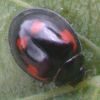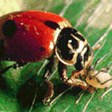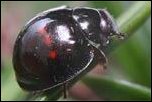|
Biological
control (By Andreas Barboutsis)
 |
|
Exochomus
quadripustulatus
|
For the pest management of insect pests the biological control methods are suggested to reduce the toxicity danger of insecticides to
man, animals and environment.
The biological pest control has a lot of advantages most important of which are the safety of its application to man and
environment, the permanent results and the maintenance of balance in the
ecosystem.
 |
|
Adonia
variegata
|
In many applications of biological pest control for insect pests in urban and suburban green
places, as well as in extensive agricultural practice, there have been occasionally mass applications of beneficial and other organisms
(such as entomopathogenic fungi) with much effectiveness.
These beneficial organisms can be produced after reproduction in the
insectary, or been supplied from the trade.
 |
|
Chilocorus
bipustulatus |
The usual entomological pests that we see today in green
places, where the application of biological pest control is possible, are mainly insect pests from aphids
(Hemiptera: Aphidoidea), scale insects (Hemiptera: Coccoidea), whiteflies (Hemiptera:
Aleyrodidae), larvae (Lepidoptera) etc.
Examples of such applications that have been applied successfully are the
following:
|
Pest
|
Biological
control agent (beneficial organism)
|
Category
of beneficial organism
|
|
Wooly
whitefly
Aleurothrixus floccosus
|
Cales
noacki
|
Insect
|
|
Mealybugs
Planococcus
citri
P.
ficus
|
Leptomastidea
ambnormis
Anagyrus
sp
Cryptolaemus
montrusieri
Exochomus
quadripustulatus
|
Insects
|
|
Aphids
|
Aphidius
matricariae
Lysiphlebus testaceipes
Scymnus sp
Coccinella septempunctata
Adonia variegata
|
Insects
|
|
Scale
insects
(Coccidae, Diaspididae)
|
Chilocorus
bipustulatus
Rhyzobius
lophanthae
Scutellista
cyanea
Metaphycus helvolus
|
Insects
|
|
Larvae
of Lepidoptera
|
Bacillus
thurigiensis
|
Bacillus
|
Andreas Barboutsis
Agriculturist
www.plantland.gr
|
